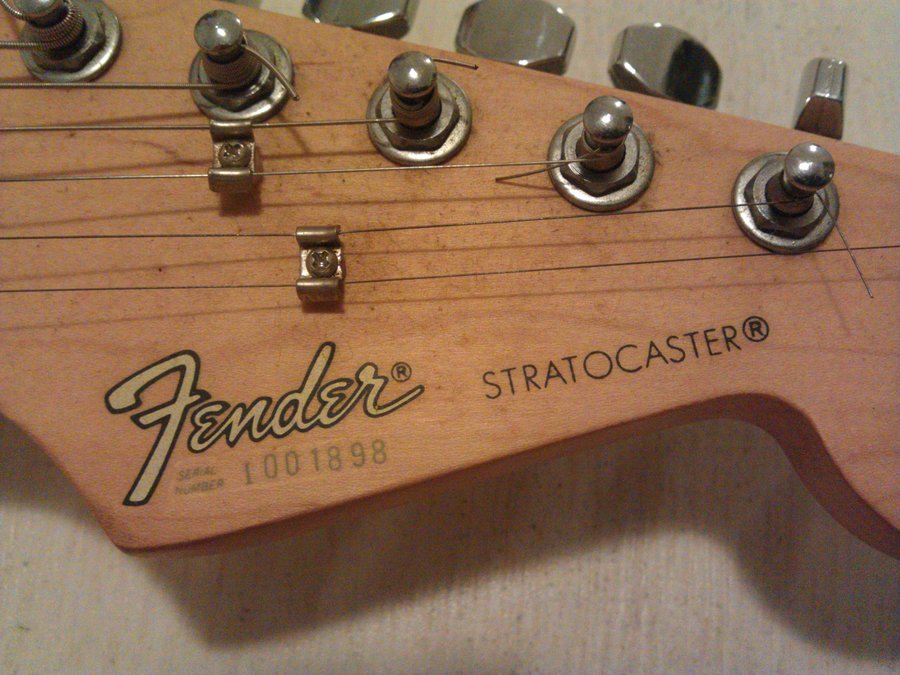Fender Stratocaster Model From Serial Number
1958 Fender Stratocaster 3 color sunburst Manufacturer Period 1954–present Construction Body type Neck joint Scale 25.5 in (648 mm) Woods Body Neck Fretboard Hardware Bridge Usually proprietary 6-screw locking system Usually 3 (SSS) or 2 Single-coils with Hot Bridge (HSS) on certain models. Other pickup configurations (H/HH/HSH/HHH) are also available Colors available Various 2- or 3-color sunbursts Black Other standard or custom colors, blue, pink, red, yellow. The Fender Stratocaster is a model of designed in 1954 by,,,. The has continuously manufactured the Stratocaster from 1954 to the present. Settlement marker installation. It is a double- guitar, with an extended top 'horn' shape for balance. Along with the and, it is one of the most-often emulated electric guitar shapes.

Also, the N6XXXXX serial number does indicate the Strat in question is a USA, but if it's a Fat Strat it's not the special model.
'Stratocaster' and 'Strat' are terms belonging to Fender. Guitars that duplicate the Stratocaster by other manufacturers are usually called S-Type or ST-type guitars. The Stratocaster is a versatile guitar, usable for most styles of music and has been used in many genres, including,,,,,,,,,,.
Contents • • • • • • • • Design developments [ ] The Fender Stratocaster was the first guitar to feature three pickups and a spring tension, as well as being the first Fender with a contoured body. The Stratocaster's sleek, contoured body shape (officially referred to by Fender as the 'Comfort Contour Body' ) differed from the flat, slab-like design of the. The Stratocaster's double cutaways allowed players easier access to higher positions on the neck. Starting in 1954, the Stratocaster was offered with a solid, deeply contoured body, a 21-fret one-piece maple neck with black dot inlays, and Kluson tuning machines.
The color was originally a two color sunburst pattern, although custom color guitars were produced (most famously 's gold Stratocaster, dated 6/1954). In 1956, Fender began using for sunburst and most custom color Stratocaster bodies; was still used on translucent blonde instruments.
In 1960, the available custom colors were standardized, many of which were automobile lacquer colors from available at an additional 5% cost. A unique single-ply, 8-screw hole white (changed to an 11-screw hole 3-ply in late 1959) held all electronic components except the recessed jack plate—facilitating easy assembly. Original Stratocasters were manufactured with five tremolo springs, allowing the bridge set up to 'float'. In the floating position, players can move the bridge-mounted up or down to modulate the pitch of the notes being played., and have used the Stratocaster's floating vibrato extensively in their playing. As string gauges have changed, players have experimented with the number of tremolo springs, and as the average gauge has decreased over the years, modern Stratocasters are equipped with three springs as a stock option in order to counteract the reduced string tension. While the floating bridge has unique advantages, the functionality of the 'floating' has been accepted and disputed by many musicians. As the bridge floats, the instrument has a tendency to go out of tune during double-stop string bends.
Many Stratocaster players opt to tighten the tremolo springs (or even increase the number of springs used) so that the bridge is firmly anchored against the guitar body: in this configuration, the tremolo arm can still be used to slacken the strings and therefore lower the pitch, but it cannot be used to raise the pitch (a configuration sometimes referred to as 'dive-only'). Some players, such as and, feel that the floating bridge has an excessive propensity to detune guitars and so inhibit the bridge's movement with a chunk of wood wedged between the bridge block and the inside cutout of the tremolo cavity, and by increasing the tension on the tremolo springs; these procedures lock the bridge in a fixed position. Some Stratocasters have a fixed bridge in place of the tremolo assembly; these are colloquially called 'hard-tails'.